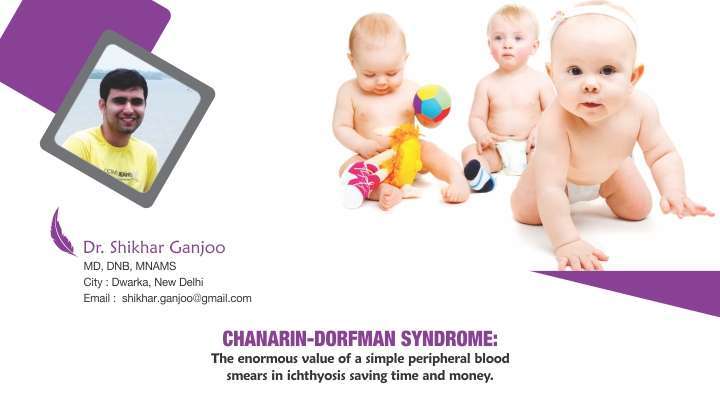Abstract:
Chanarin-Dorfman syndrome (CDS) is a rare nonlysosomal autosomal recessive neutrophil lipid storage disorder characterized by deposition of cytoplasmic neutral lipid droplets in many cell types. It is clinically characterized by nonbullous congenital ichthyosiform erythroderma, hepatomegaly, myopathy, ataxia, neurosensory hearing loss and varying developmental delay. A peripheral blood smear showing lipid droplets in granulocytes is highly suggestive of the diagnosis.
Case Report:
A 14 month old, developmentally normal for age male child, born out of second degree consanguineous marriage presented to us with complaints of upper abdominal distension for three weeks, dry skin with peeling since neonatal period and strabismus. On examination the child had generalized ichthyosis and hepatomegaly. There was no ataxia, nystagmus, or deafness or clinical signs of peripheral neuropathy or myopathy. Similar skin lesions were present in his cousin. We considered the differentials of non-bullous congenital icthyosiform erythroderma, lamellar ichthyosis and Chanarin-Dorfman syndrome.
On investigation peripheral blood smear revealed presence of vacuolated neutrophils (Jordan’s anomaly). Liver enzymes were mildly elevated (alanine transaminase 93 IU/L and aspartate transaminase 112 IU/L) with normal bilirubin levels. Lipid profile was normal. Liver biopsy showed macrovesicular steatosis with features of cirrhosis and steatohepatitis. Skin biopsy was consistent with nonbullous icthyosiform erythroderma with presence of vacuolated keratinocytes and vacuolated cells in eccrine gland. The skeletal and ophthalmological evaluation was normal.
With these typical features a diagnosis of CDS was considered. Isotretinoin 10 mg twice a week and emollients were prescribed along with a diet rich in medium chain triglycerides and deficient in long chain fatty acids. Follow up of the patient at 4 and 8 weeks showed progressively significant improvement in cutaneous lesions and normalization of liver function tests. Thus, a simple peripheral blood smear should be done to rule out CDS in any child presenting with ichthyosis and systemic involvement.
Discussion:
Chanarin-Dorfman syndrome is a rare autosomal recessive metabolic disorder with deposition of cytoplasmic neutral lipid droplets in many cell types, in particular hepatocytes, keratinocytes and granulocytes. CDS is characterized by nonbullous congenital ichthyosiform erythroderma, hepatomegaly and varying degree of developmental delay. Muscle weakness (or myopathy), ataxia, neurosensory hearing loss, subcapsular cataracts and nystagmus can be present.1 Expression of the syndrome is variable, but the diagnosis can be easily confirmed by a peripheral blood smear, which shows lipid droplets in granulocytes, known as Jordan’s anomaly. 2 Mutations in the ABHD5 gene on chromosome 3p21 is the genetic defect responsible for CDS.3 Mutation of ABHD5 leads to deposition of triglycerides as lipid droplets in various organs due to loss of function of adipose triglyceride lipase enzyme.4,5 Our patient presented classically with congenital nonbullous icthyosiform erythroderma, hepatomegaly, strabismus and peripheral blood smear showed Jordan’s anomaly. Histopathological examination revealed deposition of lipid vacuoles in hepatocytes, keratinocytes, and eccrine glands.
References:
- Srebrnik A, Brenner S, Ilie B et al. Dorfman–Chanarin syndrome: morphologic studies and presentation of new cases. Am J Dermato-pathol 1998; 20:79–85.
- Rozenszajn L, Klajman A, Yaffe D et al. Jordan’s anomaly in white blood cells. Report Case Blood 1966; 28:258 – 265
- Emre S, Unver N, Evans SE et al. Molecular analysis of Chanarin–Dorfman syndrome (CDS) patients: identification of novel mutations in the ABHD5 gene. Eur J Med Genet 2010;53:141–4
- Dorfman ML, Hershko C, Eisenberg S et al. Ichthyosiform dermatosis with systemic lipidosis. Arch Dermatol 1974;110:261– 266.
- Lass A, Zimmermann R, Haemmerle G et al. Adipose triglyceride lipase-mediated lipolysis of cellular fat stores is activated by CGI-58 and defective in Chanarin–Dorfman Syndrome. Cell Metab 2006;3:309–19.






